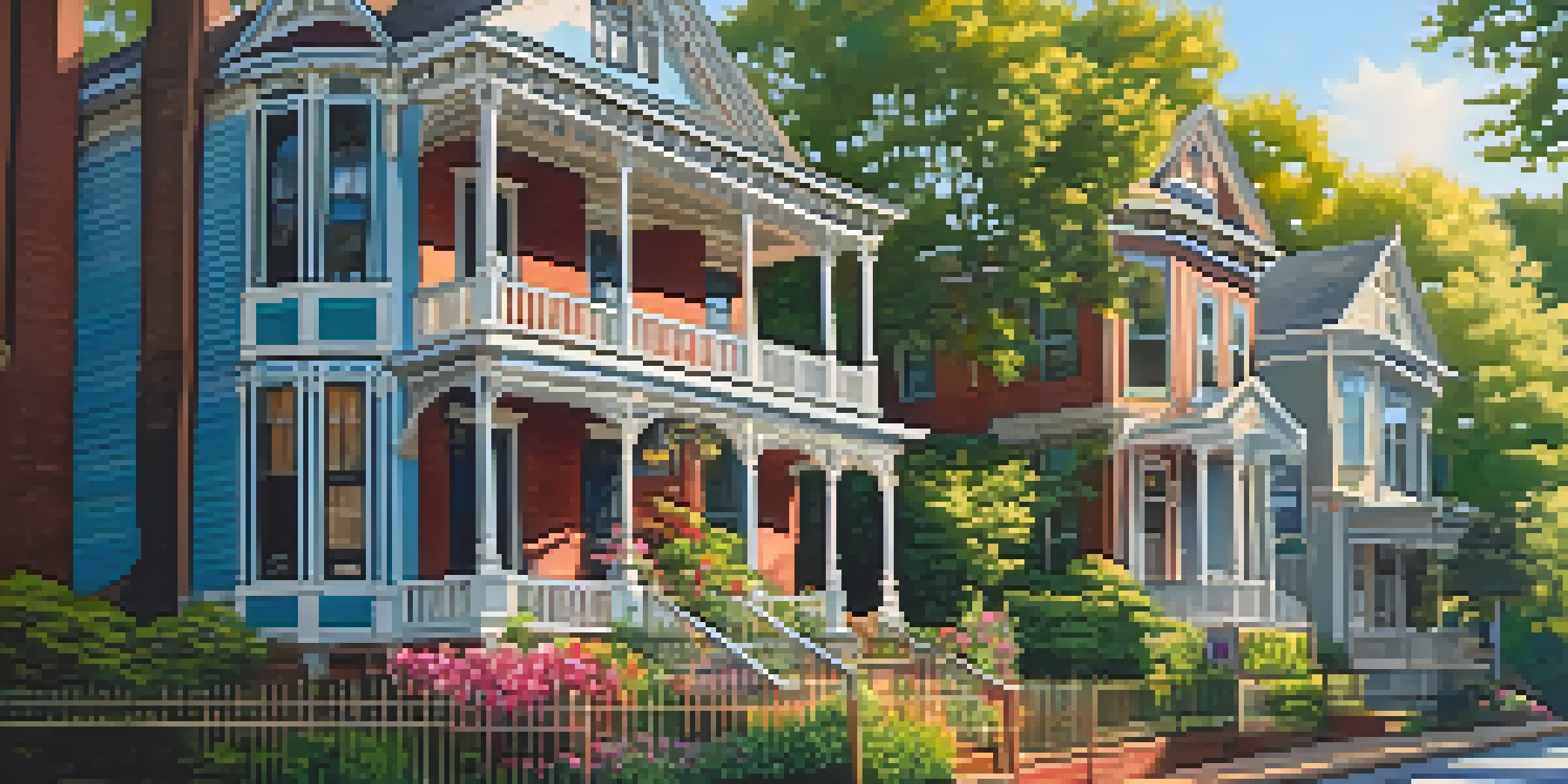The Legacy of Atlanta's Historic Neighborhoods and Homes

The Evolution of Atlanta's Historic Neighborhoods
Atlanta's historic neighborhoods have undergone significant transformations over the years, reflecting the city's growth and changing demographics. From the early days of the Civil War to the civil rights movement, these areas have witnessed pivotal moments in American history. Each neighborhood tells a unique story, shaped by the people who lived there and the events that unfolded.
The past is never dead. It's not even past.
For instance, neighborhoods like Sweet Auburn became centers of African American culture and commerce during the early to mid-20th century. The architecture and layout of these areas reflect their rich history and the social dynamics at play. By exploring these neighborhoods, we can gain insight into the resilience and adaptability of Atlanta's communities.
Today, these historic neighborhoods are not just remnants of the past; they are vibrant spaces where history and modern life intertwine. As new developments rise alongside century-old homes, the legacy of these areas continues to influence Atlanta's identity.
Architectural Styles That Define Atlanta
One of the most striking features of Atlanta's historic neighborhoods is the variety of architectural styles that can be found. From Victorian mansions to Craftsman bungalows, each style tells a story about the era in which it was built. These homes not only showcase the skill of their builders but also reflect the cultural influences of their time.

Take, for example, the iconic Victorian homes in Inman Park, which were built during the late 1800s. Their ornate details and vibrant colors stand as a testament to the wealth and optimism of that period. On the other hand, the Craftsman homes found in neighborhoods like Cabbagetown highlight a more modest, yet equally charming, approach to design that emerged in the early 20th century.
Historic Neighborhoods Reflect Growth
Atlanta's historic neighborhoods showcase the city's evolution, highlighting pivotal moments and the diverse cultures that shaped them.
Exploring these architectural styles allows us to appreciate the craftsmanship and artistic vision of Atlanta's past. Each home is like a piece of a puzzle, contributing to the larger narrative of the city’s evolution.
Cultural Significance of Atlanta's Historic Homes
Beyond their architectural beauty, Atlanta’s historic homes serve as cultural landmarks that embody the spirit of the city. Many of these homes have hosted notable figures, from civil rights leaders to artists, making them vital pieces of Atlanta’s narrative. Their stories enrich our understanding of the struggles and triumphs that have shaped the community.
Preservation is the foundation of our culture and our future.
For instance, the Martin Luther King Jr. National Historical Park includes the home where Dr. King was born and raised. This site is not only a tribute to his legacy but also a reminder of the broader civil rights movement that took root in Atlanta. Such homes provide a tangible connection to the past, allowing visitors to walk in the footsteps of those who made history.
By preserving these homes, we honor the cultural significance they hold and ensure that future generations can learn from them. They stand as reminders of the resilience and determination that define Atlanta.
Community Revitalization and Historic Preservation
In recent years, there has been a growing awareness of the importance of preserving Atlanta's historic neighborhoods. Community revitalization efforts aim to strike a balance between modern development and the protection of these cultural treasures. Local organizations and residents work together to ensure that the unique character of each neighborhood is maintained.
For example, the Atlanta Preservation Center actively advocates for the protection of historic properties and educates the public about their significance. These initiatives have led to successful restoration projects that breathe new life into dilapidated homes while respecting their historical integrity. The result is a blend of old and new that enhances the neighborhood's appeal.
Preservation Balances Modernity
Efforts to revitalize Atlanta's historic areas prioritize preserving cultural treasures while accommodating contemporary development.
As these revitalization efforts continue, the future of Atlanta's historic neighborhoods looks promising. By fostering a sense of pride and community, residents are ensuring that their rich history remains a vital part of the city's identity.
The Role of Local Government in Preservation
Local government plays a crucial role in the preservation of Atlanta's historic neighborhoods and homes. Through policies and ordinances, city planners and officials work to protect these areas from overdevelopment while promoting sustainable growth. This balance is essential for maintaining the character and historical significance of Atlanta's neighborhoods.
For instance, zoning laws can help regulate what types of buildings can be constructed in historic areas, ensuring that new developments complement the existing architecture. Additionally, tax incentives for homeowners who restore historic properties encourage preservation efforts. Such policies not only protect the past but also enhance community pride and property values.
Collaboration between local government and community members is key to successful preservation efforts. By engaging residents in the decision-making process, Atlanta can continue to honor its history while evolving as a modern city.
Tourism and Economic Impact of Historic Neighborhoods
Atlanta's historic neighborhoods are not only culturally significant but also economically beneficial for the city. They attract tourists who are eager to explore the rich history and vibrant culture that these areas offer. This influx of visitors supports local businesses, from restaurants to shops, creating a thriving economic ecosystem.
Take the historic district of Midtown, for example, which draws crowds with its charming streets and historic sites. Tourists often participate in guided tours, which educate them about the neighborhood's history while generating revenue for local tour operators. This symbiotic relationship between tourism and preservation helps sustain the community's heritage.
Tourism Boosts Local Economy
The charm of Atlanta's historic neighborhoods attracts tourists, supporting local businesses and enhancing the city's economic landscape.
As more people discover the charm of Atlanta's historic neighborhoods, the potential for economic growth increases. By investing in preservation, the city can continue to foster a vibrant tourism sector while honoring its rich history.
Embracing the Future While Honoring the Past
As Atlanta continues to grow and evolve, the challenge lies in embracing the future while honoring the past. The city's historic neighborhoods are a testament to its rich history, but they also hold the potential for innovation and progress. By integrating modern development with historical preservation, Atlanta can create a unique urban landscape that respects its roots.
For instance, adaptive reuse of historic buildings allows for new purposes while maintaining their original charm. A former school building may be transformed into trendy lofts, providing modern living spaces without sacrificing the structure's historical value. Such creative solutions can breathe new life into old spaces, making them relevant for future generations.

Ultimately, the legacy of Atlanta's historic neighborhoods and homes lies in their ability to inspire and connect people. By valuing both history and innovation, the city can ensure that its past continues to enrich its future.